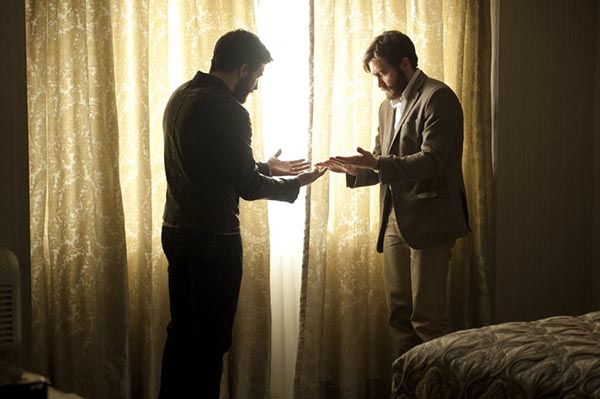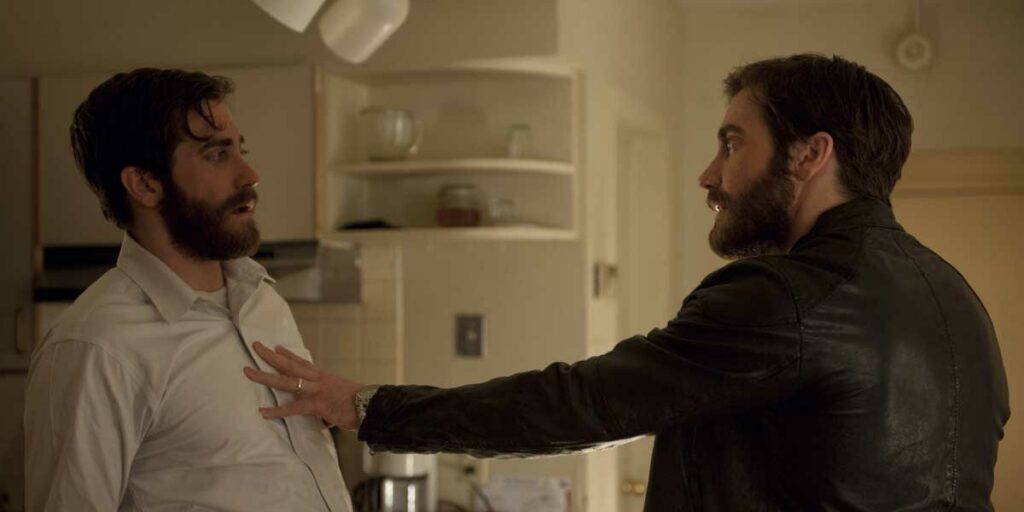With his breakthrough horror feature Enemy, Denis Villeneuve explores the idea that there’s nothing quite as frightening as ourselves.
This analysis contains spoilers for ‘Enemy’.
“Chaos is order yet undeciphered.”
Adam Bell is a downbeat college history professor living alone in Toronto. Anthony Claire is a successful actor living just around the corner with his pregnant wife. They couldn’t be further from each other – and yet, they’re the same person. Jake Gyllenhaal’s dual performance is filled with subtle details to distinguish the two, but these two man have much more in common than just their looks. When Adam first encounters his other half on a DVD recommended to him by a friend, he embarks on a desparate investigation to uncover the truth about Anthony and quickly becomes infatuated with his life.
The pair enter a whirlwind of paranoia and jealousy, bringing each other’s lives down from the inside until neither can go any further. Enemy is always pretty ambiguous on the subject of whether Adam and Anthony are literally the same person, but this reading of the story presents some extremely disturbing consequences that seem fitting with the rest of Denis Villeneuve’s filmography. Adam and Anthony represent inverse sides of the same personality: while the former is reserved, alone, and enamored by the prospect of a more exciting life, the latter has that exact lifestyle that Adam desires and still finds himself jealous of his other half. Neither can be truly happy whilst presented with the ideal of what they could be, and this forces them to dig themselves deeper and deeper into that false identity.
Enemy isn’t a movie that can be understood in a simple, linear way: it’s incredibly stylized, and the scenes in which Adam and Anthony appear together basically exist outside of the film’s continuity. There’s no way they can actually be in the same room if they’re the same person, but these scenes are indicative of how one personality perceives the other. In that first interaction between the two, Adam is frightened by his doppelgänger’s confidence and success, while Anthony is fascinated and intrigued by the latter’s more relaxed lifestyle. It’s the first real indicator that they’re both unhappy in their own lives, and want to displace their other self.
Jealousy and envy are natural aspects of the human condition, and the fact that Adam/Anthony experiences these feelings towards his own self is actually a satirical decision from Villeneuve that proves how impossible it is for humans to be entirely selfless towards others. These two men are literally the same person, and they’re still jealous of each other.

The explosive conclusion of Enemy sees Villeneuve push these ideas to a whole new level. After fully integrating himself into Adam’s life, Anthony essentially steals his girlfriend and gets them both (seemingly) killed in a car crash. This leaves Adam with the perfect opportunity to adopt Anthony’s identity for good and steal the life he always wanted. It’s a terrifying display of how toxic and damaging this kind of self-absorbed jealousy can be, with the ‘death’ of one personality being the only way that Adam/Anthony can truly be at peace.
Villeneuve’s exploration of self-hatred and inherent jealous is sharp and brutal, but there’s an even darker implication hidden within that dark ending. Anthony’s death is never actually shown on-screen, and knowing Villeneuve’s incredibly precise storytelling, that’s probably not a coincidence. Another reading of the film adheres to the theory that Adam and Anthony are the same person – but displaced through time. Many have suggested that it’s actually Adam in the crash (as much as separate versions of the same person can ever just be one identity), and he survives the accident to return home to his wife – which is when he becomes the character that audiences have come to know as Anthony. The entire story is one dark cycle, with Adam/Anthony constantly cheating on his wife and displacing his two identities to deal with the consequences.
Enemy is an inherently ambiguous story that never gives a concrete answer regarding Adam/Anthony’s identity. They could be different people, they could be the same person, they could even be the same person at different points in time – what’s important is that they’re representative of the cyclical nature of the human condition. Enemy’s final shot is extremely telling of this – when Adam/Anthony returns home, he discovers a letter (which audiences know belongs to the club where Anthony cheats on his wife) and Helen transforms into a spider. Throughout the film, the spider is used as a recurring motif for lust and infidelity – so this final shot is proving that Adam/Anthony plans to have another affair (or his first, if you’re reading Enemy as a non-linear narrative).
The character is destined to destroy his own life over and over again at the hands of his own self-hatred and inbuilt jealousy. Both sides of his personality are constantly at war with one another, battling for what they can’t have and pretending to have what they don’t. It’s actually a deeply sad story: the life of a man who’s so lost within himself that he’s forced to split his consciousness in order to comprehend his total inability to be happy. Everything is scattered and illogical, which is exactly how Villeneuve wants to paint humanity. Nothing we do makes sense, and everything is our own fault – even if we often want to blame somebody else for our selfish failures.
Enemy is now available to watch on digital and on demand.

